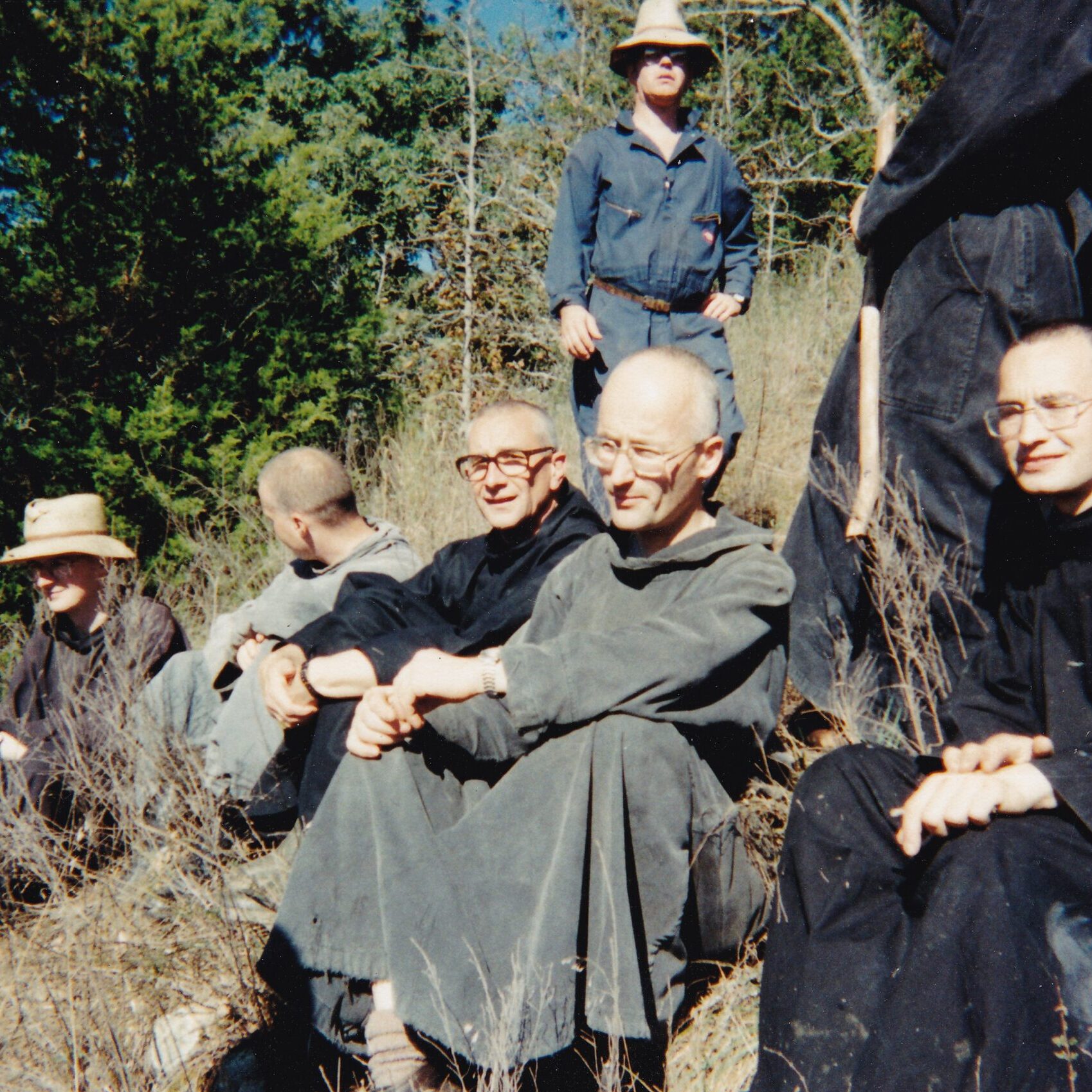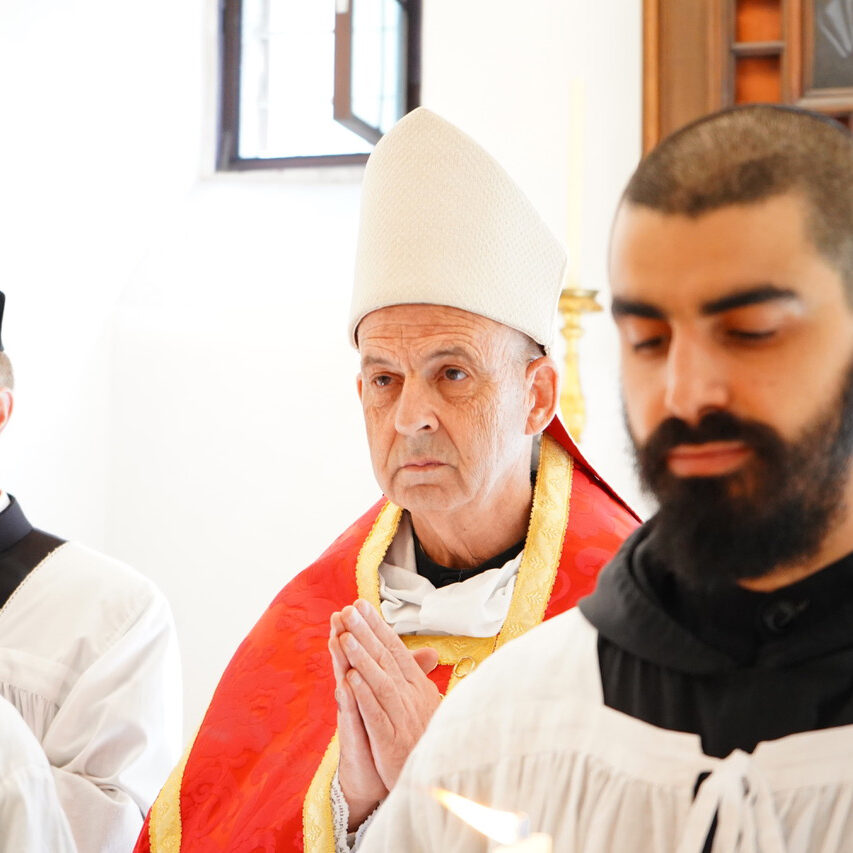Dear Friend,
This letter begins with a story. It is the story of the grace of God and a group of quite ordinary young men — a “band of brothers” — who were called upon to live a great adventure some thirty years ago.
In the fall of 1975, I finished my active duty in the United States Marine Corps and was ready to pursue an ideal that had previously come into my head during the time I spent at a large, mid-western university studying the Great Books of Western Civilization.
How did those three professors persuade so many of us, so very much in tune with our turbulent and confused generation to shift our radicalism to a higher and better sphere? In any case, I found myself once again packing my Marine Corps duffel bag (with warm civilian clothes this time) and setting out for the appointed place of this adventure — Notre Dame de Fontgombault Abbey in France.
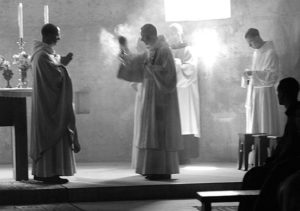 There are vocations or “callings” for places just as for persons. Fontgombault is one of those special places in the world, where the spiritual and material realms meet in a kind of antechamber of Heaven. Upon entering the Romanesque church situated near the Creuse River, the lingering smell of incense adds to the mystery of the high-vaulted ceiling and the gentle light filtering through the stained-glass windows.
There are vocations or “callings” for places just as for persons. Fontgombault is one of those special places in the world, where the spiritual and material realms meet in a kind of antechamber of Heaven. Upon entering the Romanesque church situated near the Creuse River, the lingering smell of incense adds to the mystery of the high-vaulted ceiling and the gentle light filtering through the stained-glass windows.
Seven times each day and once during the night, the accents of Gregorian chant make the stone walls vibrate with the oldest and most beautiful and prayerful music our civilization has yet to produce. A taste of Paradise?
A few other Americans had preceded me to the French Benedictine Abbey, where they were already testing their vocation to the religious life. It may seem surprising that a group of American university students should find their calling in a French monastery, but something told us it would all work out.
From the beginning, we hoped to bring this particular type of monastic life (the purely contemplative kind, involving no outside pastoral duties, such as tending to parishes or schools) back to the United States. For the time being, though, we had to settle into the daily rhythm of this life, divided roughly between eight hours of prayer, eight hours of work (both manual and intellectual), and eight hours of sleep.
 “Ora et Labora” — Pray and Work — is the motto often ascribed to the black monks. Like most human beings after the Fall, we earn our daily bread “by the sweat of our brow.” Even work, however, is accomplished in a spirit of prayer.
“Ora et Labora” — Pray and Work — is the motto often ascribed to the black monks. Like most human beings after the Fall, we earn our daily bread “by the sweat of our brow.” Even work, however, is accomplished in a spirit of prayer.
Where did the years go? After the small group of Americans had been at Fontgombault for a little over twenty years, the Abbot, Dom Antoine Forgeot, began visiting the United States in search of a location in which to establish an American monastery. The dream became a reality in 1998 when a beautiful piece of property was secured in the foothills of the Ozarks, about seventy miles east of Tulsa, Oklahoma and a charter was signed by Bishop Edward J. Slattery, formally welcoming the monks into his diocese.
In the fall of 1999, on the threshold of a new millennium, a dozen monks — mostly Americans — arrived in Oklahoma to begin the new monastery placed under the patronage of Our Lady of the Annunciation and familiarly referred to as Our Lady of Clear Creek Monastery.
Above all a monk is a man of prayer. His life says: “God exists, and we have been created for Him.” St. Benedict lived in the 6th century and is the father of Western monasticism. Over the centuries, Benedictine monks have played a quiet but decisive role in the preservation and development of civilization. You might say with little exaggeration that they built Europe.
By their balanced life, monks offer an example of how to praise God and respect His creation, how to love one’s neighbor and practice the moderate use of material goods. Benedictine communities have always been a source of inspiration for all who visit them — whether individuals or families.
It is hard for us who have lived this monastic adventure not to see the hand of Divine Providence at work. The contemplative religious life, wholly dedicated to prayer, is a rarity in our world, particularly in our bountiful and industrious America, so given to business and activity of every kind.
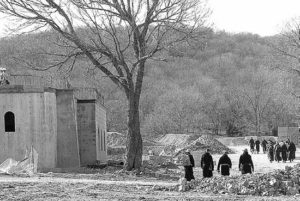 Perhaps more than any other people on earth, Americans need a place to reconnect with God’s creation and with the silent center of their own being where God awaits them. The monastery is such a place. Guests, both men and women, are welcome to come stay with us for a few days and share in our life of prayer and work.
Perhaps more than any other people on earth, Americans need a place to reconnect with God’s creation and with the silent center of their own being where God awaits them. The monastery is such a place. Guests, both men and women, are welcome to come stay with us for a few days and share in our life of prayer and work.
At Clear Creek, the Divine Office (the official prayer of the Church), and Holy Mass are celebrated daily in Latin and sung in Gregorian chant. The Clear Creek monks earn their living the way monks always have: from their farm, their vegetable garden, and their orchard. They also make their own cheese, clothes, and furniture.
Since its inception, Clear Creek has been blessed with a large number of vocations. In nine short years, the number of monks has grown from 13 to over 30. Others are waiting to visit us in view of discerning their vocation, and inquiries come every day — a wonderful and encouraging sign for any religious community!
Benedictines have a long history of architectural accomplishments: they have always been audacious builders. Romanesque architecture is part of the Benedictine heritage and meets the needs of a solemn liturgical life. The Liturgy, the natural setting, the church building, and the monks themselves together form a living prayer. In such a place, visitors from all walks of life participate in a mode of existence that has been a sanctifying presence in our culture for well over a thousand years.
With this Benedictine ideal as our goal, Thomas Gordon Smith, a well-known architect and professor at the University of Notre Dame, was chosen to design a permanent church and a large residential building. In 2002, consulting engineers were hired and a road and a stone bridge leading to the new church were constructed.
After a process of competitive bidding, Manhattan Construction Company of Tulsa was hired to build the new monastery. By the end of March 2004, the foundations had been poured and the whole basement level successfully completed.
The next big challenge was the building of the monastery Residence. Ever since the founding of Clear Creek, the monks have lived in an old lodge building that was generously donated along with the property. But we soon outgrew that building and as more and more novices arrived, we were forced to build a series of small modular sheds in which to house these new vocations.
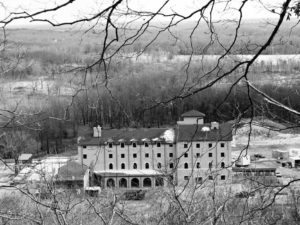 And so it was that we greeted the completion of the permanent Monastery Residence (pictured at the left) with much joy and gratitude. On January 2nd of this year, we were able to move into our new Residence, and on April 12th the formal dedication was made with Bishop Edward J. Slattery presiding and hundreds of friends of Clear Creek in attendance.
And so it was that we greeted the completion of the permanent Monastery Residence (pictured at the left) with much joy and gratitude. On January 2nd of this year, we were able to move into our new Residence, and on April 12th the formal dedication was made with Bishop Edward J. Slattery presiding and hundreds of friends of Clear Creek in attendance.
As monks, our day-to-day needs are relatively small and we do not ordinarily need to reach out far beyond the monastery walls for financial assistance. The cost of building, however, has always been great — now more than ever. With the grace of God and your assistance, this miracle will happen. But we truly need your help!
With the completion of the Residence, we must now focus on the true heart of the Benedictine Monastery: the Abbatial Church. Monks strive to live in strict poverty as concerns their personal needs. A church is something different though, something that must be beautiful for God. Please help us build an “antechamber of Heaven,” a habitation as worthy as possible for the Lord of Heaven and earth.
The enclosed DVD is entitled Ecce, Fiat, and is the work of a gifted young filmmaker, who prefers to remain anonymous. Although this little documentary does not pretend to tell the whole story about Our Lady of Clear Creek Monastery, we think you will appreciate the beauty of what it does portray, especially if you have not had the opportunity to visit us in person.
br. Philip Anderson, Prior
Dear Friend,
This letter begins with a story. It is the story of the grace of God and a group of quite ordinary young men — a “band of brothers” — who were called upon to live a great adventure some thirty years ago.
In the fall of 1975, I finished my active duty in the United States Marine Corps and was ready to pursue an ideal that had previously come into my head during the time I spent at a large, mid-western university studying the Great Books of Western Civilization.
How did those three professors persuade so many of us, so very much in tune with our turbulent and confused generation to shift our radicalism to a higher and better sphere? In any case, I found myself once again packing my Marine Corps duffel bag (with warm civilian clothes this time) and setting out for the appointed place of this adventure — Notre Dame de Fontgombault Abbey in France.
 There are vocations or “callings” for places just as for persons. Fontgombault is one of those special places in the world, where the spiritual and material realms meet in a kind of antechamber of Heaven. Upon entering the Romanesque church situated near the Creuse River, the lingering smell of incense adds to the mystery of the high-vaulted ceiling and the gentle light filtering through the stained-glass windows.
There are vocations or “callings” for places just as for persons. Fontgombault is one of those special places in the world, where the spiritual and material realms meet in a kind of antechamber of Heaven. Upon entering the Romanesque church situated near the Creuse River, the lingering smell of incense adds to the mystery of the high-vaulted ceiling and the gentle light filtering through the stained-glass windows.
Seven times each day and once during the night, the accents of Gregorian chant make the stone walls vibrate with the oldest and most beautiful and prayerful music our civilization has yet to produce. A taste of Paradise?
A few other Americans had preceded me to the French Benedictine Abbey, where they were already testing their vocation to the religious life. It may seem surprising that a group of American university students should find their calling in a French monastery, but something told us it would all work out.
From the beginning, we hoped to bring this particular type of monastic life (the purely contemplative kind, involving no outside pastoral duties, such as tending to parishes or schools) back to the United States. For the time being, though, we had to settle into the daily rhythm of this life, divided roughly between eight hours of prayer, eight hours of work (both manual and intellectual), and eight hours of sleep.
 “Ora et Labora” — Pray and Work — is the motto often ascribed to the black monks. Like most human beings after the Fall, we earn our daily bread “by the sweat of our brow.” Even work, however, is accomplished in a spirit of prayer.
“Ora et Labora” — Pray and Work — is the motto often ascribed to the black monks. Like most human beings after the Fall, we earn our daily bread “by the sweat of our brow.” Even work, however, is accomplished in a spirit of prayer.
Where did the years go? After the small group of Americans had been at Fontgombault for a little over twenty years, the Abbot, Dom Antoine Forgeot, began visiting the United States in search of a location in which to establish an American monastery. The dream became a reality in 1998 when a beautiful piece of property was secured in the foothills of the Ozarks, about seventy miles east of Tulsa, Oklahoma and a charter was signed by Bishop Edward J. Slattery, formally welcoming the monks into his diocese.
In the fall of 1999, on the threshold of a new millennium, a dozen monks — mostly Americans — arrived in Oklahoma to begin the new monastery placed under the patronage of Our Lady of the Annunciation and familiarly referred to as Our Lady of Clear Creek Monastery.
Above all a monk is a man of prayer. His life says: “God exists, and we have been created for Him.” St. Benedict lived in the 6th century and is the father of Western monasticism. Over the centuries, Benedictine monks have played a quiet but decisive role in the preservation and development of civilization. You might say with little exaggeration that they built Europe.
By their balanced life, monks offer an example of how to praise God and respect His creation, how to love one’s neighbor and practice the moderate use of material goods. Benedictine communities have always been a source of inspiration for all who visit them — whether individuals or families.
It is hard for us who have lived this monastic adventure not to see the hand of Divine Providence at work. The contemplative religious life, wholly dedicated to prayer, is a rarity in our world, particularly in our bountiful and industrious America, so given to business and activity of every kind.
 Perhaps more than any other people on earth, Americans need a place to reconnect with God’s creation and with the silent center of their own being where God awaits them. The monastery is such a place. Guests, both men and women, are welcome to come stay with us for a few days and share in our life of prayer and work.
Perhaps more than any other people on earth, Americans need a place to reconnect with God’s creation and with the silent center of their own being where God awaits them. The monastery is such a place. Guests, both men and women, are welcome to come stay with us for a few days and share in our life of prayer and work.
At Clear Creek, the Divine Office (the official prayer of the Church), and Holy Mass are celebrated daily in Latin and sung in Gregorian chant. The Clear Creek monks earn their living the way monks always have: from their farm, their vegetable garden, and their orchard. They also make their own cheese, clothes, and furniture.
Since its inception, Clear Creek has been blessed with a large number of vocations. In nine short years, the number of monks has grown from 13 to over 30. Others are waiting to visit us in view of discerning their vocation, and inquiries come every day — a wonderful and encouraging sign for any religious community!
Benedictines have a long history of architectural accomplishments: they have always been audacious builders. Romanesque architecture is part of the Benedictine heritage and meets the needs of a solemn liturgical life. The Liturgy, the natural setting, the church building, and the monks themselves together form a living prayer. In such a place, visitors from all walks of life participate in a mode of existence that has been a sanctifying presence in our culture for well over a thousand years.
With this Benedictine ideal as our goal, Thomas Gordon Smith, a well-known architect and professor at the University of Notre Dame, was chosen to design a permanent church and a large residential building. In 2002, consulting engineers were hired and a road and a stone bridge leading to the new church were constructed.
After a process of competitive bidding, Manhattan Construction Company of Tulsa was hired to build the new monastery. By the end of March 2004, the foundations had been poured and the whole basement level successfully completed.
The next big challenge was the building of the monastery Residence. Ever since the founding of Clear Creek, the monks have lived in an old lodge building that was generously donated along with the property. But we soon outgrew that building and as more and more novices arrived, we were forced to build a series of small modular sheds in which to house these new vocations.
 And so it was that we greeted the completion of the permanent Monastery Residence (pictured at the left) with much joy and gratitude. On January 2nd of this year, we were able to move into our new Residence, and on April 12th the formal dedication was made with Bishop Edward J. Slattery presiding and hundreds of friends of Clear Creek in attendance.
And so it was that we greeted the completion of the permanent Monastery Residence (pictured at the left) with much joy and gratitude. On January 2nd of this year, we were able to move into our new Residence, and on April 12th the formal dedication was made with Bishop Edward J. Slattery presiding and hundreds of friends of Clear Creek in attendance.
As monks, our day-to-day needs are relatively small and we do not ordinarily need to reach out far beyond the monastery walls for financial assistance. The cost of building, however, has always been great — now more than ever. With the grace of God and your assistance, this miracle will happen. But we truly need your help!
With the completion of the Residence, we must now focus on the true heart of the Benedictine Monastery: the Abbatial Church. Monks strive to live in strict poverty as concerns their personal needs. A church is something different though, something that must be beautiful for God. Please help us build an “antechamber of Heaven,” a habitation as worthy as possible for the Lord of Heaven and earth.
The enclosed DVD is entitled Ecce, Fiat, and is the work of a gifted young filmmaker, who prefers to remain anonymous. Although this little documentary does not pretend to tell the whole story about Our Lady of Clear Creek Monastery, we think you will appreciate the beauty of what it does portray, especially if you have not had the opportunity to visit us in person.
br. Philip Anderson, Prior


